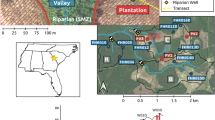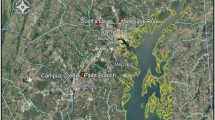Abstract
The long-term capacity of riparian zones in regulating groundwater nitrate fluxes is not well understood. This study analyses patterns of nitrate removal for the period 1994–2012 at two sites in a river floodplain that have received high groundwater nitrate loading from a large upland aquifer for over 32 years. During the study, mean NO3 −–N concentrations entering the riparian zone varied between 20–30 and 30–42 mg/L at the upstream and downstream sites respectively, but did not show any clear inter-annual trend. A permeable sand layer in the riparian zone is underlain by a regional aquitard at a depth of 5–6 m and 4 m at the upstream site and downstream site respectively. Denitrification resulted in a decline in nitrate concentrations as lateral groundwater flow in the sand layer interacted with buried peat and channel bar deposits that range up to 3 m in depth at both riparian sites. This interaction was greater at the downstream site where the organic deposits extend down to <1 m from the aquitard in some locations. At the upstream site nitrate removal efficiency in the sand layer, at depths of 3–4 m ~20 m from the river bank, declined from 68 % in 1996–1998 to 42 % in 2009–2012. A smaller decline from 92 to 82 % occurred in the sand layer 10 m from the river bank during the study. In contrast, no clear pattern of change was evident at the downstream site where a nitrate removal efficiency of 98–100 % occurred at the river bank in most years between 1994 and 2012. These data suggest that the long-term nitrate removal performance of some riparian zones may decline if carbon availability for denitrification becomes limited as a result of variations in the quantity, quality and location of subsurface organic deposits that interact with deeper groundwater flowpaths.








Similar content being viewed by others
References
Aber JD, Nadelhoffer KJ, Steudler P, Melillo JM (1989) Nitrogen saturation in northern forest ecosystems. BioScience 39:378–386
Aber JD, McDowell W, Nadelhoffer KJ, Magill A et al (1998) Nitrogen saturation in temperate forest ecosystems. Hypotheses revisited. Bioscience 48:921–934
Bravo D, Hill AR (2012) The effect of chronic high groundwater nitrate loading on riparian forest growth and plant-soil processes. Water Air Soil Pollut 223:73–84
Devito KJ, Fitzgerald D, Hill AR, Aravena R (2000) Nitrate dynamics in relation to lithology and hydrologic flow path in a river riparian zone. J Environ Qual 29:1075–1084
Environment Canada (1979) Analytical methods manual. Inland Water Directorate, Water Quality Branch, Ottawa
Gurwick NP, Groffman PM, Yavitt JB, Gold AJ, Blazejewski G, Stolt M (2008) Microbially available carbon in buried riparian soils in a glaciated landscape. Soil Biol Biochem 40:85–96
Hanson GC, Groffman PM, Gold AJ (1994) Symptoms of nitrogen saturation in a riparian wetland. Ecol Appl 4:750–756
Haycock NE, Pinay G (1993) Groundwater nitrate dynamics in grass and poplar vegetated riparian buffer strips during the winter. J Environ Qual 22:273–278
Hefting M, Beltman B, Karssenberg D, Rebel K, Van Riessen M, Spijker M (2006) Water quality dynamics and hydrology in nitrate loaded riparian zones in the Netherlands. Environ Pollut 139:143–156
Hill AR (1982) Nitrate distribution in the groundwater of the Alliston region of Ontario, Canada. Ground Water 20:696–702
Hill AR (1983) Denitrification: its importance in a river draining an intensively cropped watershed. Agric Ecosyst Environ 10:47–62
Hill AR (1996) Nitrate removal in stream riparian zones. J Environ Qual 25:743–755
Hill AR (2012) The impact of pipe flow in riparian peat deposits on nitrate transport and removal. Hydrol Process 26:3135–3146
Hill AR, Cardaci M (2004) Denitrification and organic carbon availability in riparian wetland soils and subsurface sediments. Soil Sci Soc Am J 68:320–325
Hill AR, Devito KJ, Campagnolo S, Sanmugadas K (2000) Subsurface denitrification in a forest riparian zone: interactions between hydrology and supplies of nitrate and organic carbon. Biogeochemistry 51:193–223
Hill AR, Vidon PGF, Langat J (2004) Denitrification potential in relation to lithology in five headwater riparian zones. J Environ Qual 33:911–919
Kendall MG (1975) Rank correlation methods. Charles Griffin, London
Long LM, Schipper LA, Bruesewitz DA (2011) Long-term nitrate removal in a denitrification wall. Agric Ecosyst Environ 140:514–520
Lowrance RR, Todd RL, Asmussen LE (1984) Nutrient cycling in an agricultural watershed: 1 Phreatic movement. J Environ Qual 13:22–27
Nihlgard B (1985) The ammonium hypothesis- an additional explanation to the forest decline in Europe. Ambio 14:495–505
Peterjohn WT, Correll DL (1984) Nutrient dynamics in an agricultural watershed: observations on the role of the riparian forest. Ecology 65:1466–1475
Phillips RTJ, Robert A (2005) River incision in relation to post-glacial events in the Humber River basin, Ontario. Geogr Phys Quat 59:17–30
Ranalli AJ, Macalady DL (2010) The importance of the riparian zone and in-stream process in nitrate attenuation in undisturbed and agricultural watersheds: a review of the scientific literature. J Hydrol 389:406–415
Robertson WD, Cherry JA (1995) In situ denitrification of septic-system nitrate using reactive porous media barriers: field trials. Ground Water 33:99–111
Robertson WD, Vogan JL, Lombardo PS (2008) Nitrate removal rates in a 15-year old permeable reactive barrier treating septic system nitrate. Ground Water Monit Remediat 28:65–72
Sabater S, Butturini A, Clement JC, Burt T, Dowrick D et al (2003) Nitrogen removal by riparian buffers along a European climatic gradient: patterns and factors of variation. Ecosystems 6:20–30
Schipper LA, Vojvodic-Vukovic M (1998) Nitrate removal from groundwater using a denitrification wall amended with sawdust: field trial. J Environ Qual 27:664–668
Shabaga JA, Hill AR (2010) Groundwater-fed surface flow path hydrodynamics and nitrate removal in three riparian zones in southern Ontario, Canada. J Hydrol 388:52–64
Sibul U, Choo-Ying AV (1971) Water resources of the Upper Nottawasaga River drainage basin. Ontario Water Resources Commission Water Resources Report 3
Technicon (1977) Nitrate and nitrite in water and sea water. Industrial Method 158-71 WIA Technicon Industrial System. Tarrytown, New York
Ullah S, Zinati GM (2006) Denitrification and nitrous oxide emission from riparian forest soils exposed to prolonged nitrogen runoff. Biogeochemistry 81:253–267. doi:10.1007/s10533-006-9040-8
Vidon PG, Hill AR (2006) A landscape-based approach to estimating riparian hydrological and nitrate removal functions. J Am Water Res Assoc 42:1099–1112. doi:10.1111/j.1752-1688.2006.tb0415.x
Acknowledgments
We thank Chris Browne, Dennis Colautti, Sonia Campagnolo, Graham Carlyle, Dan Fitzgerald, Daryl Leblance, Camelia Rusmir, Jason Shabaga, Greg Taylor, and Cherie Westbrook for field assistance and Shan Sanmugadas and Jackson Langat for laboratory assistance. Thanks are also due to Carolyn King in the York Geography department cartographic office for the figures. We are grateful to four anonymous reviewers for their helpful comments on the manuscript. Funding was provided by the National Sciences and Engineering Research Council of Canada operating grants to A.R. Hill and K.J. Devito.
Author information
Authors and Affiliations
Corresponding author
Additional information
Responsible Editor: Jonathan Sanderman.
Rights and permissions
About this article
Cite this article
Hill, A.R., Devito, K.J. & Vidon, P.G. Long-term nitrate removal in a stream riparian zone. Biogeochemistry 121, 425–439 (2014). https://doi.org/10.1007/s10533-014-0010-2
Received:
Accepted:
Published:
Issue Date:
DOI: https://doi.org/10.1007/s10533-014-0010-2




